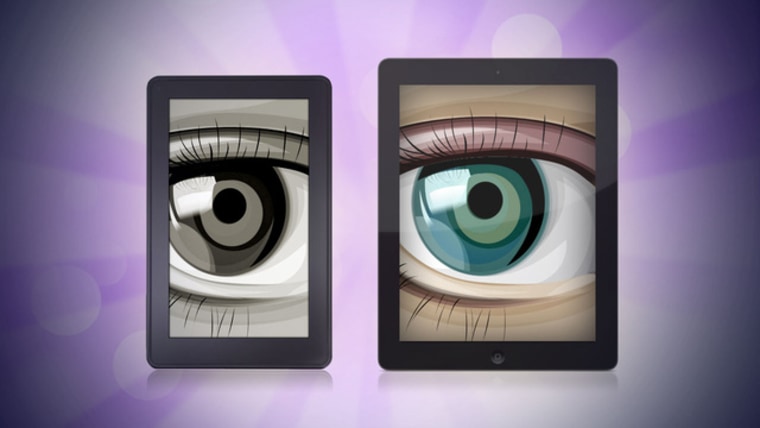Q. I've heard that tablets with bright screens — like the iPad—can cause eyestrain and other problems. Am I better off getting an e-ink device like the Kindle or the Nook?
A. The common belief goes like this: because tablet screens are backlit and emit blue light, they cause greater eye fatigue than e-ink, which isn't backlit and is designed to look like a piece of paper rather than a screen. Anecdotally, I've always believed this to be true; in fact, the headaches I get most evenings (and their absence when I wear Gunnar glasses) would seem to back that up. However, all the research I could find on e-Ink claims that they don't offer any eyestrain benefits over LCDs. The New York Times explains:
Today's screens are definitely less tiring to look at than older displays, which refreshed the image much less frequently, causing a flicker. Carl Taussig, director of Hewlett-Packard‘s Information Surfaces Lab, said the 120 Hz refresh rate typical of modern screens is much quicker than our eyes can even see."The new LCDs don't affect your eyes," Mr. Taussig said. "Today's screens update every eight milliseconds, whereas the human eye is moving at a speed between 10 and 30 milliseconds."
If that's true, then it's certainly possible that my glasses are just a placebo, or that perhaps they solve problems not related to LCD screens directly, but to reading — and that they'd help just as much if I spent all day blogging on an e-ink screen without breaks. Regardless, the research says "no"— e-ink isn't inherently better for your eyes.
Update: Joe Croft, co-founder and EVP of Research Design and Development at Gunnar (the company that makes those glasses), shot us an email with his thoughts about the differences between LCDs and e-ink. In particular, he noted two things that separate LCDs:
Glare and visual "noise": Most tablets (e.g. iPad) have a glossy screen. I believe most e-ink screens are optimized for a matte screen, which allows our eyes to relax in a more natural state, but does not address some of the other issues associated with eye strain, such as distance and reduced blink rate.
Quality of light: Our eyes are designed to process natural, reflected light better than self-illuminated objects (i.e. artificial light). e-ink wins in this regard and can help reduce strain when compared to LCD screens.
This would be more in keeping with my own personal observations, but it looks like expert opinion is still very much up in the air.
However, each type of screen does have its own indisputable advantages and disadvantages. Some examples:
- Tablets like the iPad are much harder to read in bright light, and their screens can produce a lot of glare. E-ink screens, on the other hand, work fantastically in bright light.
- E-ink has a low contrast ratio that is difficult to read in low light. Tablets, being backlit, are much easier to read in darker situations.
- Tablets may be great in low light, but if you're reading them in the dark — particularly at night — the blue light can cause insomnia and other problems. In that case, a paper book might be best —it's easier to read than e-ink in low light, and doesn't come with the problems of a tablet.
In the end, everyone is different, and you need to pick the type of screen that fits your needs. If you're looking for an e-reader to accompany you to the beach, you'll definitely want to go e-ink. If you're looking to read inside and during the daytime, an iPad or Kindle Fire may be better. And, no matter what you're reading on, take a break every 20 minutes or so if your eyes are feeling tired. That's going to be a much bigger cause of eyestrain than the type of screen you're using.
More from Lifehacker:
